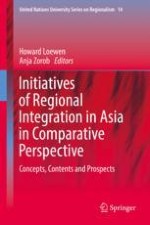This volume offers to compare and explain variances of regionalism in Asia by disclosing the distinctive features of regional arrangements and how they evolved during the 1990s and 2000s against the background of a changing global environment. Moreover, it takes up a genuinely ‘inter-Asian’ perspective. By analysing and comparing diverse manifestations of regional integration agreements across Asia and its different sub-regions, it sets out to track their common characteristics and sub-regional facets with respect to their establishment, design and consequences. In addition, political processes accompanying their negotiation and implementation are scrutinized. The analysis encompasses nine case studies written by renowned scholars who together as a group combine an extraordinary mixture of different disciplinary backgrounds as well as expertise on shapes and processes of regional integration in different parts of Asia. The case studies seize on some of the most important features and controversial issues characterizing the second regionalism. Such are the emergence and impact of overlapping FTAs, regional financial and sub-regional economic integration and cooperation, power and the politics of regional integration as well as the nexus between conflict resolution, state failure and regional integration.
